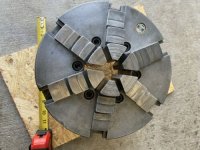scsmith42
Cast Iron
- Joined
- Jul 28, 2020
- Location
- New Hill, NC
I've searched the archives, but I haven't found a thread with a problem similar to mine.
I'm the new owner of a South Bend 17x60 Turn Nado lathe, circa 1964. The lathe is in overall good condition, and came with a 3 jaw chuck (D1-8 camlock).

Recently I acquired a used Buck 10" 6 jaw chuck with a D1-8 camlock plate included.


Yesterday I installed it and trued it up using a length of tight tolerance 1" round bar from McMaster (.0005 - 0 tolerance).
I was able to true the round bar to within .001 along the entire length of the round bar (10" protrusion). However, when I loosened the chuck, rotated the round bar and retightened, I was out .020.
Trying the round bar in several locations results in variances from .002 up to .025. There is no correlation with regard to positioning of the round bar versus orientation in the chuck.
Because I was able to originally true to within a thousandth, I'm thinking that I have a problem with respect to the jaw alignment and that they jaw's are not gripping the same way every time.
Has anybody run into this before and can offer some suggestions, short of either having the chuck refurbished or replaced?
Thanks much.
Scott
I'm the new owner of a South Bend 17x60 Turn Nado lathe, circa 1964. The lathe is in overall good condition, and came with a 3 jaw chuck (D1-8 camlock).

Recently I acquired a used Buck 10" 6 jaw chuck with a D1-8 camlock plate included.


Yesterday I installed it and trued it up using a length of tight tolerance 1" round bar from McMaster (.0005 - 0 tolerance).
I was able to true the round bar to within .001 along the entire length of the round bar (10" protrusion). However, when I loosened the chuck, rotated the round bar and retightened, I was out .020.
Trying the round bar in several locations results in variances from .002 up to .025. There is no correlation with regard to positioning of the round bar versus orientation in the chuck.
Because I was able to originally true to within a thousandth, I'm thinking that I have a problem with respect to the jaw alignment and that they jaw's are not gripping the same way every time.
Has anybody run into this before and can offer some suggestions, short of either having the chuck refurbished or replaced?
Thanks much.
Scott







